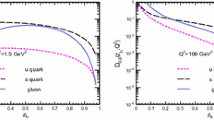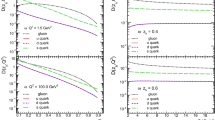Abstract
It is shown that the amplitude for the direct knockout of ρ 0 mesons plays an important role at energies W above the resonance region, W ≳ 2 GeV, and rather high values of Q 2 ≳ 1.5−2 GeV2/c 2 and that it corresponds to the t pole in the channel of the virtual decay p → p + π 0 accompanied by quark-spin flip upon momentum transfer to the meson, π 0 + γ* T → ρ 0. The contributions of several scalar mesons (p → p + f 0 channel), the contribution of the tensor meson f 2, and effects of the interference between different contributions were taken into account in addition to the contribution of the π 0 meson. The vectorand tensor-meson-dominance models were used to estimate the respective vertex constants. Within the proposed mechanism, the differential cross sections dσ L /dt and dσ T /dt were calculated for several W and Q 2 values at which the respective total cross sections were measured by the CLAS Collaboration. Agreement with data on the transverse part of the total cross section, σ T , was attained, whereby the assumption of a dominant role of magnetic spin transitions in the meson skin of the nucleon under conditions of quasielastic-knockout kinematics is confirmed. At the same time, the contribution of spin-flip transitions is suppressed in the longitudinal part of the cross section, σ L , and this is confirmed by the results of our calculations. The behavior of the differential cross section dσ T /dt is predicted with an eye to future experiments.
Similar content being viewed by others
References
F. Güttner, G. Chanfray, H. J. Pirner, and B. Povh, Nucl. Phys. A 429, 389 (1984); H. Holtmann, A. Szczurek, and J. Speth, Nucl. Phys. A 596, 631 (1996).
V. G. Neudatchin, N. P. Yudin, and L. L. Sviridova, Yad. Fiz. 60, 2020 (1997) [Phys. At. Nucl. 60, 1848 (1997)]; N. P. Yudin, L. L. Sviridova, and V. G. Neudatchin, Yad. Fiz. 61, 1689 (1998) [Phys. At.Nucl. 61, 1577 (1998)]; V. G. Neudatchin, L. L. Sviridova, and N. P. Yudin, Yad. Fiz. 65, 594 (2002) [Phys. At. Nucl. 65, 567 (2002)].
M. Guidal, J.-M. Laget, and M. Vanderhaegen, Nucl. Phys. A 627, 645 (1997).
I. T. Obukhovsky, V. G. Neudatchin, L. L. Sviridova, and N. P. Yudin, Yad. Fiz. 66, 338, 2233 (2003) [Phys. At. Nucl. 66, 313, 2183 (2003)].
V. G. Neudatchin, I. T. Obukhovsky, L. L. Sviridova, and N. P. Yudin, Nucl. Phys. A 739, 124 (2004).
P. Brauel, T. Canzler, D. Cords, et al., Z. Phys. C 3, 101 (1979); C. J. Bebek, C. N. Brown, S. D. Holmes, et al., Phys. Rev. D 17, 1693 (1978); J. Volmer, D. Abbott, H. Anklin, et al., Phys. Rev. Lett. 86, 1713 (2001).
V. G. Neudatchin, I. T. Obukhovsky, L. L. Sviridova, and N. P. Yudin, Centr.Eur. J. Phys. 2(3), 511 (2004).
D. O. Riska and G. E. Brown, Nucl. Phys. A 679, 577 (2001).
V. G. Neudatchin, I. T. Obukhovsky, L. L. Sviridova, D. K. Fedorov, and N. P. Yudin, Yad. Fiz. 70, 889 (2007) [Phys. At. Nucl. 70, 855 (2007)].
A. Faessler, T. Gutsche, V. E. Lyubovitskji, and I. T. Obukhovsky, Phys. Rev. C 76, 025213 (2007).
G. M. Huber et al. (Jefferson Lab. F π Collab.), Phys. Rev. C 78, 045203 (2008).
D. Kharzeev, Yu. V. Kovchegov, and E. Levin, Nucl. Phys. A 690, 621 (2001); R. Enberg, L.Motyka, and G. Poludniowski, Eur. Phys. J. C 26, 219 (2002).
M. A. Pichowsky and T.-S.H. Lee, Phys. Lett. B 379, 1 (1996); Phys. Rev. D 56, 1644 (1997).
D. Roy et al., Prog. Theor. Phys. 103, 747 (2000)
Y. Oh and T.-S. H. Lee, Phys. Rev. C 69, 025201 (2004).
CLAS Collab. (C. Hadjidakis et al.), Phys. Lett. B 605, 256 (2005).
N. I. Kochelev and V. Vento, Phys. Lett. B 515, 375 (2001); Y. Oh, A. I. Titov, S. N. Yang, and T. Morii, Phys. Lett. B 462, 23 (1999); Nucl. Phys. A 684, 354 (2001).
CLAS Collab. (J. P. Santoro et al.), Phys. Rev. C 78, 025210 (2008).
V. G. Efimov and M. A. Ivanov, The Quark Confinement Model of Hadrons (IOP Publ., Bristol, 1993).
A. Faessler, T. Gutsche, V. A. Ivanov, et al., Phys. Rev. D 68, 014011 (2003).
SND Collab. (M. N. Achasov et al.), Phys. Lett. B 537, 201 (2002).
T. Branz, T. Gutsche, and V. E. Lyubovitskij, Eur. Phys. J. A 37, 303 (2008).
C. Amsler et al. (Particle Data Group), Phys. Lett. B 667, 1 (2008).
B. Renner, Nucl. Phys. B 30, 634 (1971); Phys. Lett. B 33, 599 (1970).
H. Goldberg, Phys. Rev. 171, 1485 (1968).
E. Borie and F. Kaiser, Nucl. Phys. B 126, 173 (1977).
S. B. Berger and B. T. Feld, Phys. Rev. D 8, 3875 (1973); V.M. Budnev and A. E. Kaloshin, Phys. Lett. B 86, 351 (1979); D. Parashar, Phys. Rev. D 21, 1904 (1980).
Yu. Kalashnikova et al., Phys. Rev. C 73, 045203 (2006).
M. Kirchbach and D. O. Riska, Nucl. Phys. A 594, 419 (1995); M. Kirchbach, L. Tiator, S. Neumeier, and S. Kamalov, nucl-th/9609021.
D. G. Cassel et al., Phys. Rev. D 24, 2787 (1981).
J.-M. Laget and R. Mendez-Galain, Nucl. Phys. A 581, 397 (1995).
P. V. Landshoff and O. Nachtmann, Z. Phys. C 35, 405 (1987); A. Donnachie and P. V. Landshoff, Nucl. Phys.B 244, 322 (1984); A.Donachie and P. V. Landshoff, arXiv: 0803.0686 [hep-ph].
R. A. Williams, Phys. Rev. C 57, 223 (1998); S. R. Cotanch and R. A. Williams, Phys. Lett. B 549, 85 (2002).
L. S. Kisslinger, Nucl. Phys. A 629, 30c (1998); L. S. Kisslinger and W.-H. Ma, Phys. Lett. B 485, 367 (2000); L. S. Kisslinger and M. B. Johnson, Phys. Lett. B 523, 127 (2001).
F. Giacosa, T. Gutsche, V. E. Lyubovitskij, and A. Faessler, Phys. Rev. D 72, 094006 (2005).
B. Friman and M. Soyeur, Nucl. Phys. A 600, 477 (1996).
Author information
Authors and Affiliations
Corresponding author
Additional information
Original Russian Text © I.T. Obukhovsky, V.G. Neudatchin, L.L. Sviridova, D.K. Fedorov, 2010, published in Yadernaya Fizika, 2010, Vol. 73, No. 9, pp. 1602–1616.
Rights and permissions
About this article
Cite this article
Obukhovsky, I.T., Neudatchin, V.G., Sviridova, L.L. et al. Electroproduction of ρ 0 mesons on protons in quasielastic kinematics at intermediate energies and spin-flip mechanism of direct meson knockout. Phys. Atom. Nuclei 73, 1556–1570 (2010). https://doi.org/10.1134/S1063778810090103
Received:
Accepted:
Published:
Issue Date:
DOI: https://doi.org/10.1134/S1063778810090103




